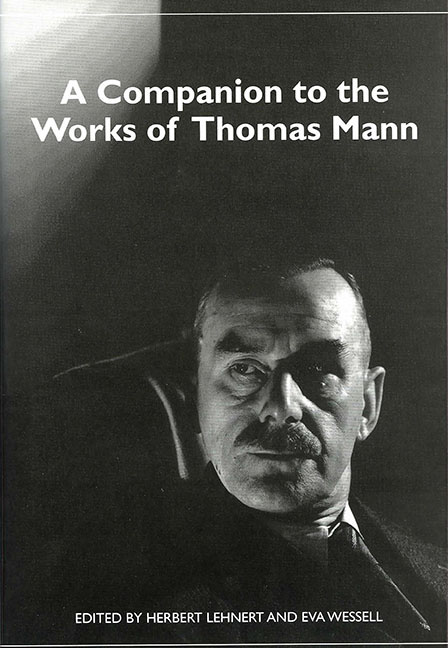Book contents
- Frontmatter
- Contents
- Foreword
- Thomas Mann's Works
- List of Abbreviations
- Introduction
- Thomas Mann's Beginnings and Buddenbrooks
- Art and Society in Thomas Mann's Early Novellas
- Love in Society: Thomas Mann's Early Stories
- “Death in Venice”
- “Mein ‘Friedrich’ — das ist was Anderes”: Thomas Mann's Unwritten Novel about Frederick the Great, King of Prussia
- Magic and Reflections: Thomas Mann's The Magic Mountain and His War Essays
- Thomas Mann's “Autobiographical” Stories
- Joseph and His Brothers
- Lotte in Weimar
- Thomas Mann's Late Politics
- “German” Music and German Catastrophe: A Re-Reading of Doktor Faustus
- The Gaze of Love, Longing, and Desire in Thomas Mann's “The Transposed Heads” and “The Black Swan”
- Felix Krull
- Female Identities and Autobiographical Impulses in Thomas Mann's Work
- Betrayed or Not Betrayed: A Testament?
- Thomas Mann's Comedies
- Notes on the Contributors
- Select Bibliography
- Index
Thomas Mann's Late Politics
Published online by Cambridge University Press: 28 April 2017
- Frontmatter
- Contents
- Foreword
- Thomas Mann's Works
- List of Abbreviations
- Introduction
- Thomas Mann's Beginnings and Buddenbrooks
- Art and Society in Thomas Mann's Early Novellas
- Love in Society: Thomas Mann's Early Stories
- “Death in Venice”
- “Mein ‘Friedrich’ — das ist was Anderes”: Thomas Mann's Unwritten Novel about Frederick the Great, King of Prussia
- Magic and Reflections: Thomas Mann's The Magic Mountain and His War Essays
- Thomas Mann's “Autobiographical” Stories
- Joseph and His Brothers
- Lotte in Weimar
- Thomas Mann's Late Politics
- “German” Music and German Catastrophe: A Re-Reading of Doktor Faustus
- The Gaze of Love, Longing, and Desire in Thomas Mann's “The Transposed Heads” and “The Black Swan”
- Felix Krull
- Female Identities and Autobiographical Impulses in Thomas Mann's Work
- Betrayed or Not Betrayed: A Testament?
- Thomas Mann's Comedies
- Notes on the Contributors
- Select Bibliography
- Index
Summary
The Relationship with the Public: The Representative
The existential problem of the young Thomas Mann was his feeling of isolation, the loneliness of the narcissist who cannot develop deeper relationships with other human beings. Freud discusses this condition as the inability to love an object. In Mann's early work he developed a veritable ideology around this problem, stylizing his inability to extend empathy to other human beings as a conflict of “Art and Life.” However, after Mann had written Buddenbrooks (1901), and after this novel had been well received by the reading public, the author had new experiences that proved helpful: a successful series of public readings from his works, the first of which took place in the spring of 1903 in Berlin. His performance was impressive; he immediately won control over the audience in the hall, and there was strong applause. The experience of this success became a fundamental asset for him as an artist. He had learned that he was able to connect with living human beings.
Mann must have noticed soon that here lay the most intense relationship with other human beings he would ever achieve. Because of this realization, he loved to perform, and constantly sought opportunities for performances that would recreate the situation: He, up there on the platform, the listening audience down in the hall — a mutual exchange between artistic achievement and grateful applause. Anyone who is familiar with such settings recognizes the erotic elements in this kind of event (something Freud showed convincingly in “Massenpsychologie und Ich-Analyse” [Group Psychology and the Analysis of the Ego, 1921]).
Before the spring 1903 reading, the contact between Mann and his reading public had been an anonymous one. Now, however, it became a living one: now his audience had faces and bodies. Yet it remained a relationship drastically different from any “normal” exchange between human beings. The exchange between a performer and his public always implies a physical separation of the parties. During the moment of contact, a space separates the artist on the podium from the audience, a gap that cannot be bridged physically (Mann himself would later even call it a “chasm” (Kluft).
- Type
- Chapter
- Information
- A Companion to the Works of Thomas Mann , pp. 203 - 220Publisher: Boydell & BrewerPrint publication year: 2004

